The ancient Chinese heritage in Guangzhou can be traced much more clearly than in other large cities of the Middle Kingdom. For example, some temples have become museums, but have retained their atmosphere, and old areas are in no hurry to rebuild. Even the not quite typical Qingping market is not closed, following the old rules. The neighborhood of natural and man-made beauties is the highlight of the iconic places of the city.
In the past, Guangzhou was influenced by Europeans, and still has not got rid of evidence from that era. When planning new buildings, tradition remains a key factor. So during the construction of the round skyscraper Guangzhou-Yuan, it was important that it is successfully reflected in the water. Thanks to this, it turns out "8", which in the superstitions of the Chinese is fortunate.
What to see and where to go in Guangzhou?
The most interesting and beautiful places for walking. Photos and a short description.
- Guangzhou TV Tower
- Huacheng Square
- Shamian Island
- Beijing walking street
- Guangzhou Yuan
- Guangzhou opera house
- Guangzhou Library
- Guangdong Provincial Museum
- Cheng clan academy
- Tomb-Museum of the Kings of the Nanyue Principality
- Sun Yat Sen Memorial Hall
- Cathedral of the Sacred Heart
- Temple of the Six Banyan Trees
- Guangxiao temple
- Huaisheng Mosque
- Qingping Market
- Yuexiu Park
- Baomo Park
- South China Botanical Garden
- Lotus mountains
- Guanyin Golden Buddha Statue
- Baiyunshan
- Safari Park Chimelong
- Chimelong Paradise Amusement Park
- Pearl river
Guangzhou TV Tower
It has a height of 610 meters, which makes it the second highest in the world. Construction ended shortly before the Asian Games in 2010. Mark Hemel won the international competition, getting the right to implement his project. The design, for all its might, looks elegant. The surface is mesh and twists slightly upwards. In addition to the TV studio, the building has office space and an observation deck.

Huacheng Square
The largest square in the city. In its current splendor, it was presented to the public in 2010 on the eve of the Asian Games. Since 2011, it has hosted the annual festival of light. The spacious pedestrian zone is illuminated at night as it is during the day. Around are various attractions, including the opera house and the new library. There are many tunnels and passages connecting metro stations and shopping centers.
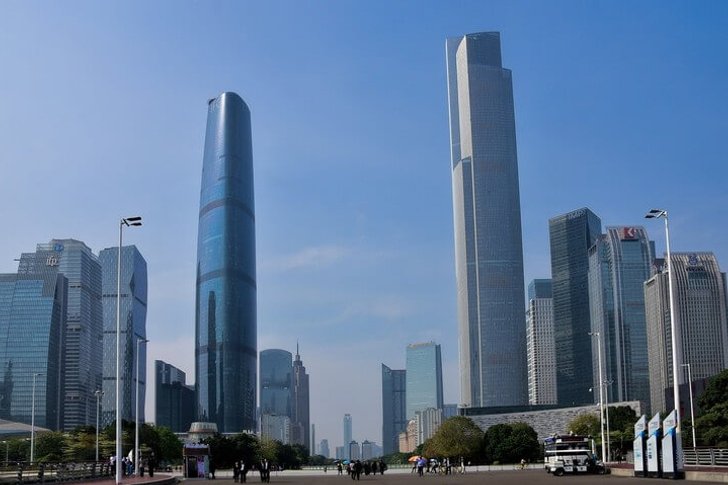
Shamian Island
For a long time was under the influence of the colonialists. It was conditionally divided between England and France. The Europeans built villas, cobbled streets, shops, restaurants and hotels. At the same time, the areas are buried in greenery. Currently, the island, separated from the mainland by a narrow strait, is a collection of architectural and cultural monuments. A hiking route is laid throughout its territory.
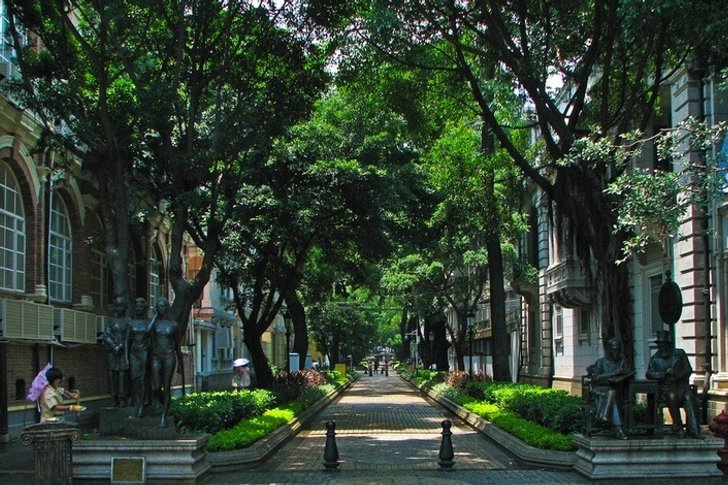
beijing walking street
It has existed for over 700 years in various forms. It is now important for the economy and tourism. Some buildings have European features, which is due to history. In the past, immigrants from England and France lived here, working at manufactories. During the inspection of architecture, it is difficult for tourists to resist and not buy something in one of several hundred stores. Trade is brisk, Beijing Street is always crowded.

Guangzhou Yuan
The tallest round building in the world, built in 2013. It looks like a wheel. Height - 138 meters, and in the center of the void. Reflected in the water, the building acquires a “continuation” and becomes like the number 8, which in Chinese superstitions is a symbol of happiness. The architect is Giuseppe di Pasquali. Although the literal translation of the name is "Guangzhou Circle", it is popularly referred to as the "golden donut".
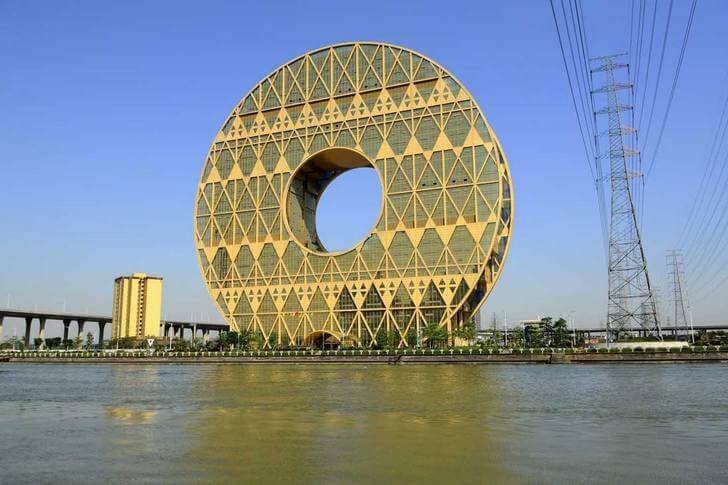
guangzhou opera house
One of the city's modern and futuristic buildings was inaugurated in 2010. The project was created by Zaha Hadid. The place was not chosen by chance: the architect was inspired by its nature, she especially liked the Zhemchuzhnaya Delta. The view of the construction is inscribed in the landscape: as if rocks washed by the waters of the river. There are 2 halls inside: the first is made of steel, the second is made of glass. They pass from one to another.

Guangzhou Library
Located in Tianhe District. Close to museum and opera house. It opened its doors to visitors in 2013. The area is 100 thousand m². More than 4 million copies of books are collected here. The library has become not just a repository of printed materials, but also a public and educational institution. There are 4,000 seats in the reading rooms. About 500 computers have been installed to search for information and work.
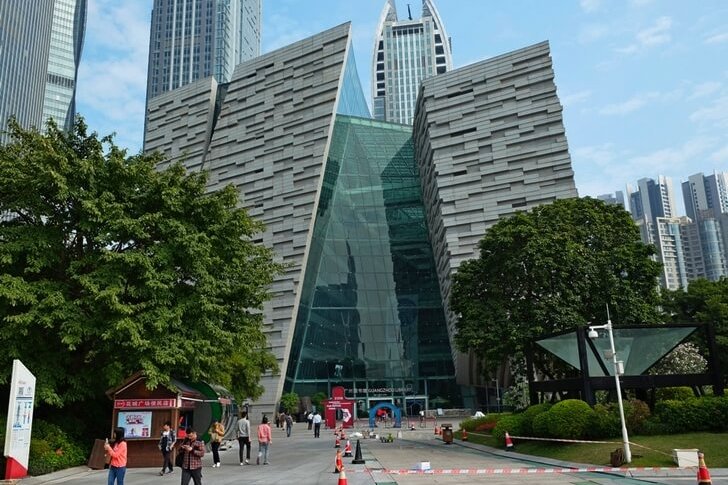
Guangdong Provincial Museum
Opened in the 1950s. Its task is to collect materials and iconic objects that tell about the culture, history and traditions of the province. The funds, numbering 160 thousand exhibits, have grown too much, and the old building of the museum was not enough. When designing a new one, the Chinese box became the prototype. The museum moved here in 2010. Of the 40,000 m² of area, about half is devoted to exhibitions.
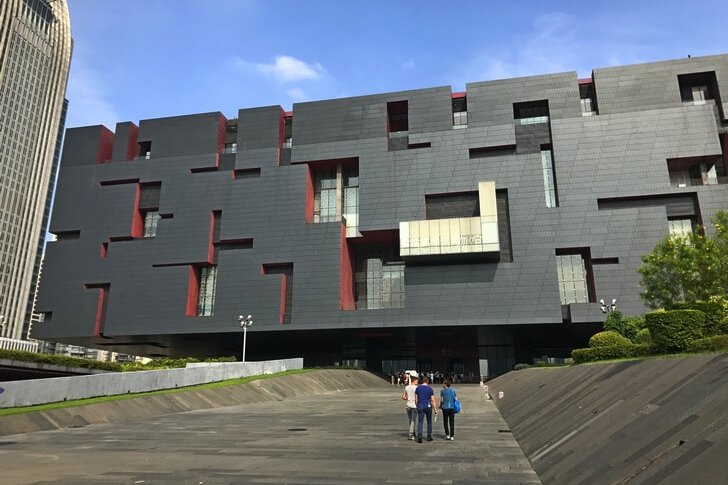
Cheng clan academy
Has existed since the 19th century. As conceived by the designers, 6 yards united 19 premises. The temple was called the Academy because numerous members of the Cheng family were trained here. The temple complex has now been converted into a museum, displaying examples of local folk arts and crafts and mentioning the Cheng family tree. In 1988, the objects were given the status of a national cultural monument.

Tomb-Museum of the Kings of the Nanyue Principality
The mausoleum is over 2000 years old. It was discovered accidentally underground during construction work in 1983. The tomb was dug up and restored. It resembles a Chinese palace. After the completion of the work, a museum was opened here. His collection is unique artifacts of different centuries. Especially valuable are the jade collection and the first golden seal of emperors dating back to the Han Dynasty.

Sun Yat Sen Memorial Hall
Built in the traditional Chinese style in 1931 on an area of 7 hectares. The building was modernized in 1998. There is a museum inside. Dedicated to the early life, work and achievements of the revolutionary Sun Yat-sen, who became the first head of communist China. His statue stands in front of the entrance, a guard is on duty around it. The memorial hall also has conference facilities, accommodating about a thousand people.
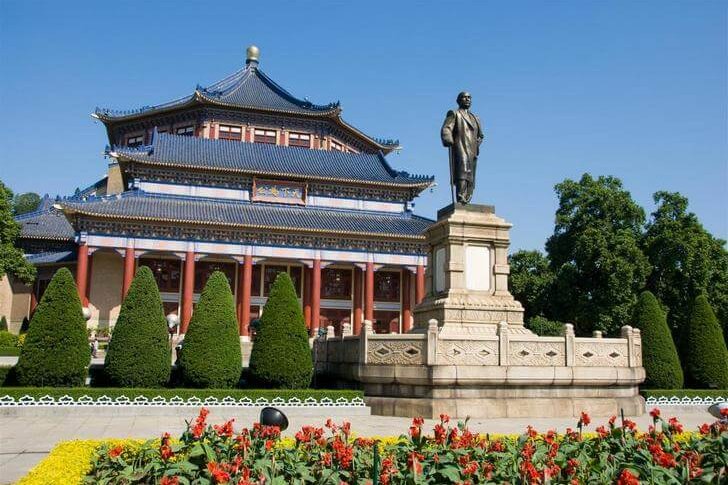
Cathedral of the Sacred Heart
The largest Christian church in China. Built in the Gothic style of granite slabs. The cathedral was founded in 1861. Due to the need to bring materials and parts from other cities and countries, construction dragged on for a quarter of a century. For example, stained-glass windows were delivered straight from France. The towers rise over 50 meters. The western one is decorated with clocks, and the eastern one has bells.
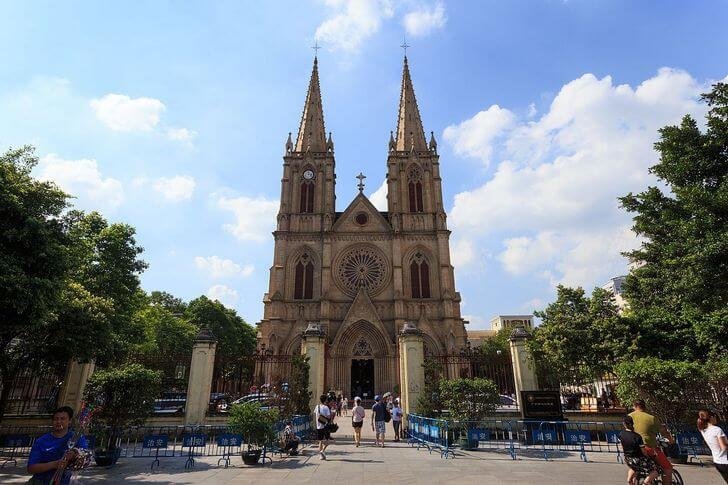
Temple of the Six Banyan Trees
Built in 537, the temple complex acquired its current name 500 years later, when a poem of the same name appeared in his honor. A banyan tree grew nearby, which created a curious landscape. The current trees are smaller. On the territory there was a place for pavilions, gazebos, a grotto and statues. The Pagoda of Flowers is part of the composition. It is one of the highest in the Middle Kingdom, as it rises to 57 meters.

guangxiao temple
The first religious buildings appeared on this site in the 4th century. However, they were often rebuilt, and the current temple differs from the prototype. It is dated to the 19th century. The main hall is decorated with a statue of a ten-meter Buddha. A special place is given to the image of the goddess of compassion Guanyin. The temple has a good reputation and is known in China primarily as the alma mater of the 6th Patriarch of Zen Buddhism Huineng.

Huaisheng Mosque
One of the oldest Muslim buildings in the world. The mosque was built about 1300 years ago, as merchants from the East sailed to the city, and they tried to create comfortable conditions for them. Of all the buildings of the complex, only the minaret has a classical look, the rest are in the Chinese style. The architectural ensemble includes: the Imam Hall, the gallery, the Vanyue attic, the Tower of Light, the repository of manuscripts and the pavilion of stone stelae.

Qingping Market
Perhaps the most controversial and discussed landmark of the city. This market was the first where peasants were allowed to trade freely. Economically, Xiaoping's initiative turned out to be profitable. However, now the orders on the market look almost wild. The fact is that here you can buy an animal, kill it without leaving the counter, and give it to the cook to cook dinner. Dried insects and animal skins are sold nearby.

Yuexiu Park
The largest park in the city has an area of approximately 200 hectares. Famous for 3 lakes and 7 hills. One of the main attractions is a sculptural composition depicting goats. It was opened in 1959. The statue is associated with the legend of saving the area from famine. In addition, the park is worth paying attention to the fragments of a dozen cannons and the Zhenhai Tower. Or visit local restaurants and walk along graceful bridges.

Baomo Park
Location - a suburb of Guangzhou. Not very large in size, but it can be attributed to the masterpieces of Chinese gardening art. The local lakes and ponds are interconnected in a variety of man-made ways. Among the unnatural beauties of the park, it is also worth highlighting the wall painting “Monkeys Devastate the Heavenly Palace” and the large sculpture “The Bloom of Charm”.
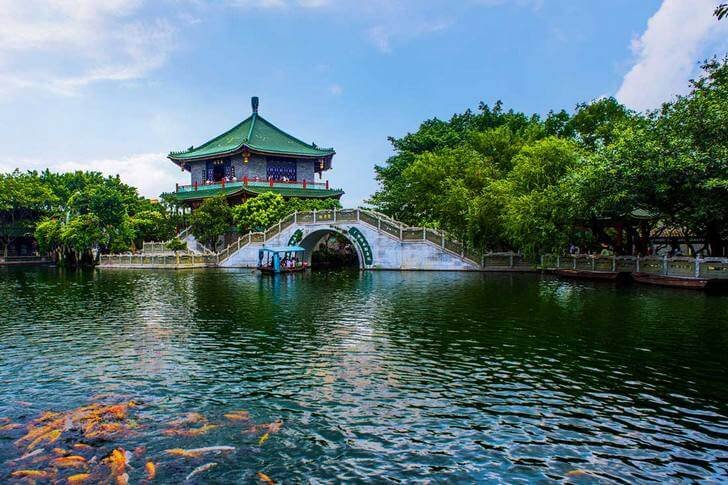
South China Botanical Garden
It is located 8 km from the city. The largest and oldest tropical botanical garden in South Asia. It was created in 1929 in connection with the need to study the evolution of plants and ecology. At the moment, about 2,400 plant species have been collected on an area of 741 hectares. The territory is divided into three zones: research, conservation and exposition. The latter has a special segment for children.

lotus mountains
The name refers to the appearance of one of the hills, similar to a Lotus flower. The old name "Stone Lion's Head" was given for the same reason. Although the beauty here is natural, it was not without human influence. In the past, for several centuries, stone was mined here for construction. For this reason, a quarry was formed. There is no forest on its slopes for a long time, but this does not spoil the overall picture.

Guanyin Golden Buddha Statue
One of the newest and most popular attractions in the Lotus Mountains. Nearby it is fashionable to find the remains of the city and the pagoda. The statue was erected in the 90s of the XX century. Its weight is more than 100 tons, and its height is about 40 meters. From the top of the mountain, the Buddha looks towards the sea. In the light, the statue shimmers in a special way. The reason lies in 10 kg of gold, which covered the bronze base.

Baiyunshan
A popular resort located in the Baiyun Mountains. Their peaks are shrouded in mist, thanks to which the name appeared, translated as "white clouds". Among the sights stand out the botanical garden and the source of Tslyulun. Mountains attract extreme sportsmen: dozens of attractions have been created for them. Tourists are taken to the main peak by electric car or funicular. Butterfly Park and Pigeon Park leave vivid impressions.
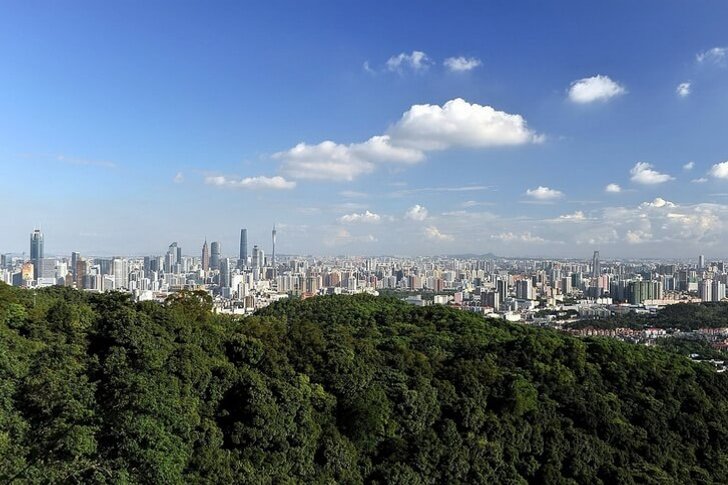
Safari Park Chimelong
Spread over 130 hectares since 1997. The total number of animals is about 10 thousand. They represent 300 species. For each population, special conditions have been created that are as close as possible to the habitat. The most popular destinations are elephant and tiger watching. There are also pets unique to the southern latitudes. For example, a polar bear. The cooling system does not give him a reason to think that he is far from his native lands.
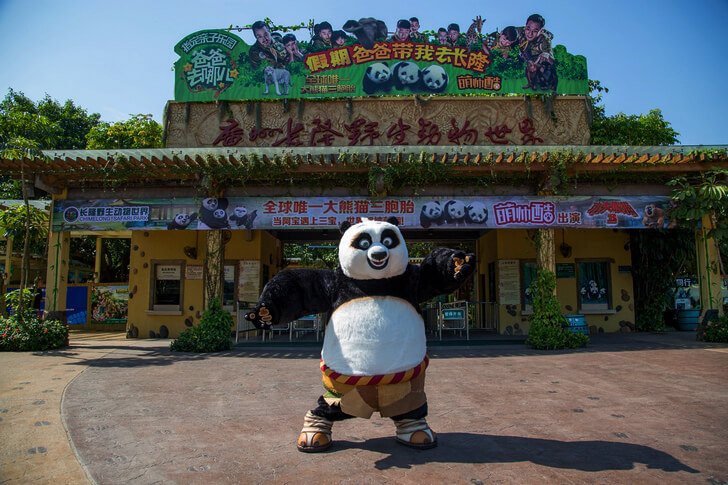
Chimelong Paradise Amusement Park
The largest amusement park in China. Built in 2006. On the territory of more than a million m² there are about a hundred attractions. Some are able to tickle the nerves of even avid fans of extreme sports. The local water park has no equal in Asia. The safari park has thousands of animals representing several hundred species. There is also a crocodile nursery, a circus, a golf course and numerous restaurants.
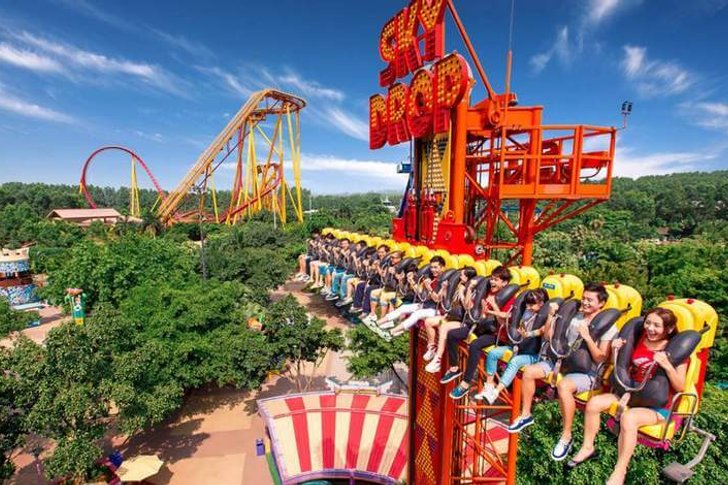
pearl river
In China, it ranks 3rd in length and 2nd in full flow. There is no exact data on the reasons for the appearance of the name. Perhaps it is associated with a valuable pearl lost here by merchants or with a rock that has become like pearls due to hundreds of years of polishing with water. Thanks to the river, Guangzhou has received a picturesque cityscape and additional tourist opportunities, such as boat trips.
